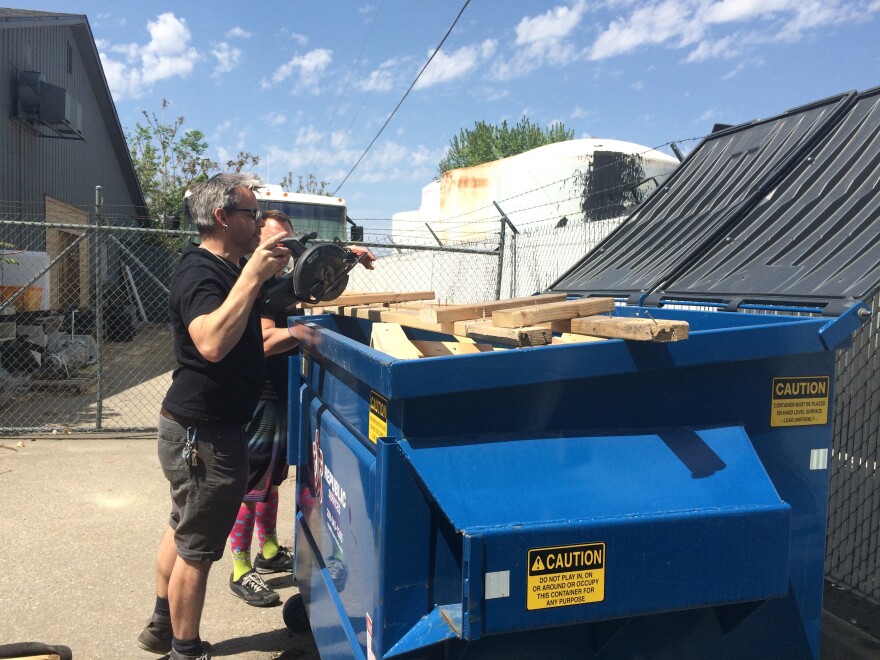There’s an increasing number of musicians, visual artists and artisans who have chosen to set up shop in Garden City. Many of these artists are from Boise or other parts of the Treasure Valley. The trend has been led by a few visionaries who recognize two things about the town: the cheap real estate, and plenty of space to practice their passion.
One of the people who saw the possibilities in Garden City for artists is Sam Stimpert. Stimpert owns the Visual Arts Collective, more commonly known as 'the VAC.' The multi-venue building sits a block north of Chinden Boulevard off 36th Street, kitty-corner from a pawn shop and surrounded by car repair businesses.
The place seems to constantly be in motion, hosting visual art shows, burlesque shows and performance art, live music, and much more.

But the venue wasn’t always in Garden City. Stimpert started the business in Boise’s Linen District. He says his rent went up substantially and he was priced out of Boise in 2007.
“I didn’t want to invest in a building that had no potential to be mine," Stimpert says. "We definitely needed that if we were going to survive – better stage, better lights, better all those things. And so we just decided to start to look somewhere else.”
He found a much more affordable spot on the other side of the river, in what used to be a Harley Davidson shop. The owners of the building were also artists. After some renovations, the VAC opened its doors in Garden City in 2008.
Since then, Stimpert has seen a lot of other Boise artists coming to Garden City.
“A lot more people are moving their studios here," he says. "I mean, I hear about that stuff all the time.”
Building A Neighborhood Of Artists
Just a few blocks away from the VAC sits a place that's also raising the profile of Garden City’s artistic community – even on an international scale. Surel’s Place is an artist-in-residency nonprofit. Visual artists, musicians, writers and dancers from around the world stay at Surel’s for short residencies.
The place is named after Surel Mitchell, a local visual artist. In the late 1990s, she sold her historic North End house in Boise and bought a cheap lot in Garden City, where she built an artist’s loft. Her daughter, Rebecca Mitchell Kelada, says her mom did it because she saw potential in Garden City.
“To find a little place across the river where people could build the kind of lives that really work for artists in an affordable way," says Mitchell Kelada. "I think was really important to her.”
Mitchell led an effort to change zoning codes to allow artists to live, work, create, and sell their art in the same space. The district is named after her, and extends from 32nd to 37th streets north of Chinden Boulevard to the Boise River. Mitchell helped convince people like Stimpert to move there, too.
“[She] wanted to be here and live her life quietly with her art," Mitchell Kelada says. "All the while doing things to improve the community for her neighbors.”
Mitchell died in 2011. But her legacy continues at Surel’s Place, which her daughter started, in part, to keep her mom’s vision alive.
“The more people come here the more they’ll realize what we’re doing and why it’s important to this specific community. And why this community’s important to the valley.”

Pam Beaumont agrees. Beaumont is the president of the Garden City city council. She helped dedicate the Surel Mitchell Live-Work-Create district, and is encouraged to see new things like breweries, wineries and art galleries popping up around town.
“That’s exciting to us, [because] it does bring new people to Garden City that maybe haven’t come to Garden City ever before or haven’t been here for years," says Beaumont. "So they can see that Garden City is growing.”
Beaumont says attracting new artists and entrepreneurs is an important part of the city’s work.
But the growth isn’t only happening in the city's designated arts district. In a non-descript looking warehouse along 38th Street, musicians Elizabeth Altmiller and her bandmate Evie Wells practice for an upcoming show. Their band is called Evil Liza, a sort of new wave girl duo with some classical vocals mixed in.
But neither of the women live in Garden City; they commute in by bike or car from other parts of the Treasure Valley. Their band is one of eight that practices and records in this music studio – called Rocket Science Sound. They split the $700 rent.

“We have bands in here until 7:00 in the morning," Altmiller says. "And nobody minds out here because it’s mostly industrial and not much sound gets out anyway. We actually had five drumkits set up at the same time in this space.”
Altmiller says that freedom to be loud isn’t something the band can find so easily in Boise.
But someday, the cheap rent and big spaces that are attracting artists to Garden City could disappear. The town’s southeast industrial district has seen a spike in housing development just a few blocks away from Rocket Science Sound. And it's possible that more new homes could be built even closer, altering the area's artistic vibe.
When it comes to these kind of change, Sam Stimpert says some is inevitable. But he hopes the gritty character that makes Garden City Garden City, doesn’t disappear as the area grows.
“I don’t want to lose the industrial vibe of it," says Stimpert. "I believe in that stuff intermixing. You know, you can have fancy condos and Clements [Concrete] near each other and it’s OK.”
Find reporter Frankie Barnhill on Twitter @FABarnhill
Copyright 2015 Boise State Public Radio




